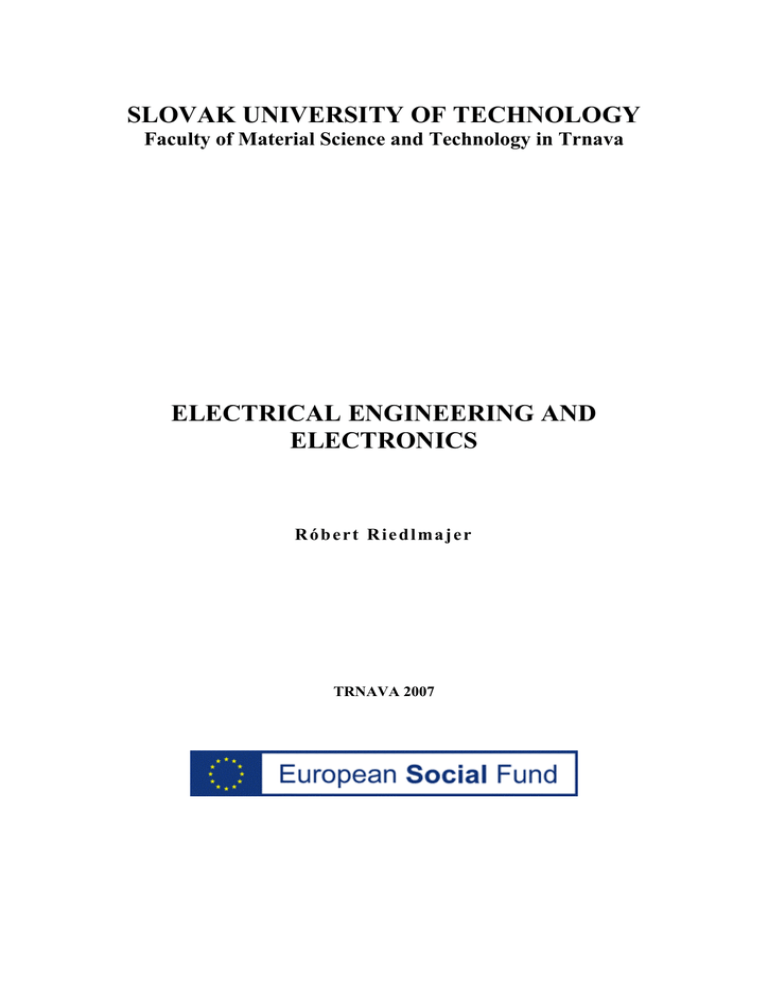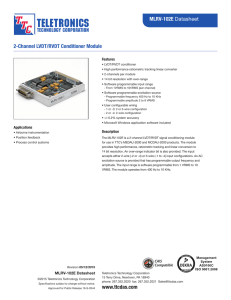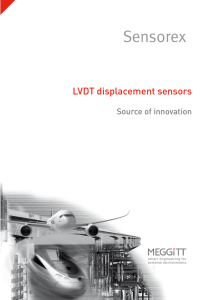DIPLOMOVA PRACA
advertisement

SLOVAK UNIVERSITY OF TECHNOLOGY Faculty of Material Science and Technology in Trnava ELECTRICAL ENGINEERING AND ELECTRONICS Róbert Riedlmajer TRNAVA 2007 ELECTRICAL ENGINEERING AND ELECTRONICS Unit 13 - Sensors Sensors convert energy information into the same or another energy form with exactly the same information content as the originating energy form (Figure 13.1). Figure 13.1: principle of sensors Definition A sensor is a device that responds to or detects a physical quantity and transmits the resulting signal to a controller. A transducer is a sensor that converts (transduces) one form of energy to another form. Position (Displacement) sensors Potentiometers The simplest type of displacement sensor involves the action of displacement in moving the wiper of a potentiometer. This device then converts linear or angular motion into a changing resistance that may be converted directly to voltage and/or current signals. (See Figure 13.2) Figure 13.2: Potentiometer These devices are in general categorized as low precision sensors and are used in low cost applications or to verify incremental high-resolution sensors. Resistive potentiometers A resistive sensor contains a translational- or angular-displacement sensing shaft. This shaft drives a wiper in the transduction element that slides along the resistive layer. The resistance measured between the wiper and one of the ends of the layer is a function of the position, motion, or displacement (Figure 13.3). 2 ELECTRICAL ENGINEERING AND ELECTRONICS a) and angular-displacement (b) resistive transducers. 1 = shaft, 2 = wiper, 3 = resistive layer. Figure 13.3: Transnational displacement Application: Throttle Position Sensor (TPS) The throttle position sensor responds to the accelerator pedal movement. This sensor is a kind of potentiometer that transforms the throttle position into output voltage, and emits the voltage signal to the electronic control unit (ECU). Figure 13.4 illustrates a sensor that provides a signal proportional to the angular position of the throttle valve. Figure 13.4: Throttle sensor Inductive Two types of transducers are popular in this measuring technique are LVDT and RVDT. LVDT denotes a linear variable differential transformer, and RVDT denotes a rotary variable differential transformer. Uex = excitation voltage, Uo = output voltage, 1 = excitation coil, 2 = output coil, 3 = moving core or armature, 4 = sensing shaft Figure 13.5: Transformer transducer, a=LVDT, b=RVDT 3 ELECTRICAL ENGINEERING AND ELECTRONICS LVDT (Linear variable differential transformer) LVDT is the most used variable-inductance transducer in industry. It is an electromechanical device designed to produce an alternative curent voltage output proportional to the relative displacement of the transformer and the armature. The Linear Variable Differential Transformer (LVDT), consists of a series of inductors in a hollow cylindrical shaft and a solid cylindrical core. The LVDT produces an electrical output proportional to the position of the core. Figure 13.6 shows that an LVDT consists of three coils of wire wound on a hollow form. When the core is centrally located in the assembly, the voltage induced in primary is equal. If the core moves to one side or the other, a larger ac voltage will be induced in one coil and a smaller ac voltage in the other because of changes in the flux linkage associated with the core. These devices can be used to observe the orientation of the wheel by measuring the displacement of a particular joint of the steering mechanism. The output is usually an analog signal proportional to the displacement. Figure 13.6: The LVDT has a movable core with the three coils RVDT (Rotational variable differential transformer) RVDT is used to measure rotational angles and operates using the same principles as the LVDT sensor. Whereas the LVDT uses a cylindrical iron core, the RVDT uses a rotary ferromagnetic core. A schematic is shown below. Figure 13.7: Typical RVDT sensor Figure 13.8: RDVT 4 ELECTRICAL ENGINEERING AND ELECTRONICS Capacitive Capacitive sensors can directly sense a variety of things—motion, chemical composition, electric field—and, indirectly, sense many other variables which can be converted into motion or dielectric constant, such as pressure, acceleration, fluid level, and fluid composition. The electrode configuration is: two close-spaced parallel plates, sphere and cylinder. C= ε 0ε r S d = 8.85 * 10 −12 εr S d Capacitive displacement The basic operation of a capacitive sensor can be seen from the familiar equation for a parallel-plate capacitor A C = kε 0 d where K = the dielectric constant Eo = permittivity = 8.85 pF/m A = plate common area d = plate separation There are two ways to change the capacity: variation of the distance between the plates (d), variation of the shared area of the plates (A), are shown in Figure 13.9. Figure 13.9: Capacity variation 5



